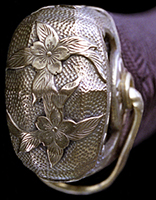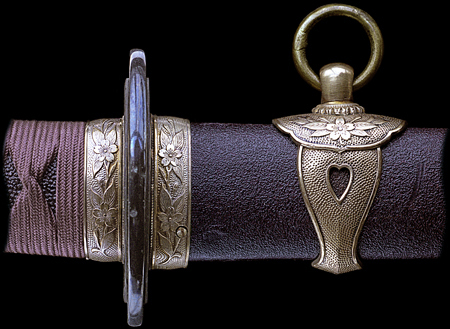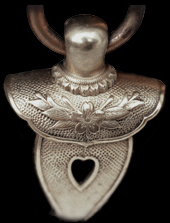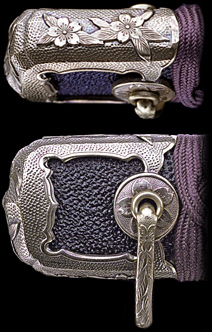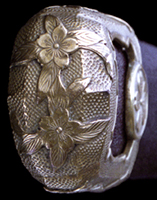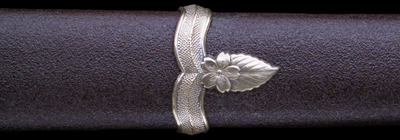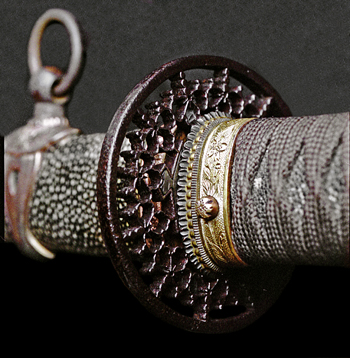海軍太刀型軍刀 (6)0
「安次」・「無銘」一佩鐶
"Yasutsugu" & "Mu-mei"(One
suspension mount)
「安次」
中期型 銘:
備中國青江住安次、新々刀又は近代刀、(刃長: 67.6㎝・反り: 2.2㎝)、紫檀色石目塗木鞘
駐爪式、士官刀緒付、金具: 金補修、柄糸諸捻巻き補修 (全長:100.4㎝)
"Yasutsugu"
Middle
type: Mei: Bicchū-koku Aoe-jū Yasutsugu, Shin shin-tō or
Modern-sword, (Blade length:
67.6㎝, Curvature: 2.2㎝), Red sandalwood color uneven coating wooden
scabbard, Spring-clip,
With the officer knot , Overall length: 100.4㎝

黒漆塗り鞘は多いが、黒以外の塗色は珍しい


青江物の新々刀又は現代刀 The present age sword of the Aoe school

|
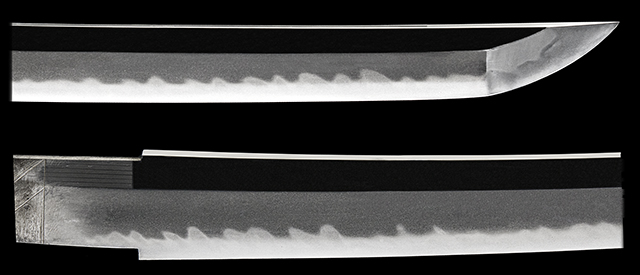
|
太刀銘: 備中國青江住安次作
Tachi-mei: Bicchū-koku
Aoe-jū Yasutsugu Saku
「備中国青江住安次」の関連で「備中国青江住貞次」と銘を切る刀匠がいた。
本名: 佐藤丈平。岡山県都窪郡早島町出身
作刀地: 東京九段鍛錬場(栗原昭秀門 貞次)
作刀時期: 昭和。国工院会員名誉宗匠・陸軍軍刀技術奨励会会長賞受賞
昭和三十九年一月五日没、享年六十二歳
「安次」は慶応~明治にかけての備中・青江の刀匠。
「安次」と「貞次」は親子又は兄弟、或は血縁のない師弟関係だったかは今後の調査に依る。
(情報ご提供: 倉敷刀剣美術館 佐藤 均 様) |

第一佩鐶(大) と 第二佩鐶(小)は大きさが違う

「無銘」一佩鐶
特注型 無銘、
古刀、(刃長:71.2㎝・反り:1.5㎝)、一吊鐶、
黒大粒鮫皮巻木鞘、特製時代鍔、全切羽装備、
駐爪式、金具: 瀬戸鍍金、士官刀緒付 (全長:
104.0㎝)
"Mu-mei"(One suspension mount)
Special
order typee: Mu-mei, Ko-to, (Blade length: 71.2㎝,
Curvature: 1.5㎝), One suspension mount,
The guard of an old age, Black polished-and-lacqurered rayskin binding
wooden scabbard,
Blade: It cuts short, Metal parts: Seto-plating, With the officer knot,
Overall length: 104.0㎝
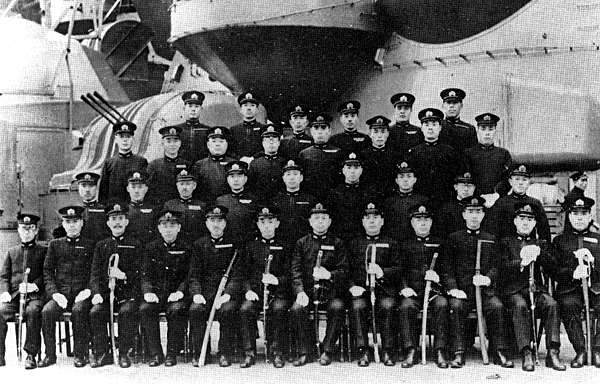
昭和20年4月初め、沖縄特攻出撃直前の戦艦「大和」甲板上に於ける乗組士官最後の記念写真 (新旧軍刀が混在している)
The commemorative photo of the last of the crew officers on a
battleship "Yamato" deck just before sortieing at
Okinawa early in April, 1945.
It was a special attack party by a surface vessel without the
possibility of a safe return.
The old and new Guntōo is intermingled.
It was 270 persons that it has come back alive among 3,300 battleship
"Yamato" crew members.
2013年11月4日より(旧サイトより移行)
ページのトップへ▲









